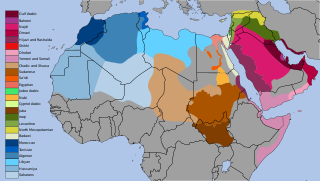
Arabical-ʻarabiyyah[alʕaraˈbijːa](listen) or ʻarabī[ˈʕarabiː](listen) or Arabic pronunciation: [ʕaraˈbij]) is a Central Semitic language that first emerged in Iron Age northwestern Arabia and is now the lingua franca of the Arab world. It is named after the Arabs, a term initially used to describe peoples living from Mesopotamia in the east to the Anti-Lebanon mountains in the west, in northwestern Arabia, and in the Sinai Peninsula. Arabic is classified as a macrolanguage comprising 30 modern varieties, including its standard form, Modern Standard Arabic, which is derived from Classical Arabic.
A prefix is an affix which is placed before the stem of a word. Adding it to the beginning of one word changes it into another word. For example, when the prefix un- is added to the word happy, it creates the word unhappy. Particularly in the study of languages, a prefix is also called a preformative, because it alters the form of the words to which it is affixed.
Akkadian is an extinct East Semitic language that was spoken in ancient Mesopotamia from the 30th century BC until its gradual replacement by Akkadian-influenced Old Aramaic among Mesopotamians by the eighth century BC.
A participle is a form of a verb that is used in a sentence to modify a noun, noun phrase, verb, or verb phrase, and plays a role similar to an adjective or adverb. It is one of the types of nonfinite verb forms. Its name comes from the Latin participium, a calque of Greek μετοχή (metokhḗ) "partaking" or "sharing"; it is so named because the Ancient Greek and Latin participles "share" some of the categories of the adjective or noun and some of those of the verb.

Arabic grammar is the grammar of the Arabic language. Arabic is a Semitic language and its grammar has many similarities with the grammar of other Semitic languages.
Egyptian Arabic, locally known as the Egyptian colloquial language, Masri or Masry, meaning simply "Egyptian", is spoken by most contemporary Egyptians.
Tagalog grammar is the body of rules that describe the structure of expressions in the Tagalog language, the language of the Tagalog region of the Philippines.

Sabaean (Sabaic), also sometimes incorrectly known as Ḥimyarite (Himyaritic), was an Old South Arabian language spoken in Yemen between c. 1000 BC and the 6th century AD, by the Sabaeans. It was used as a written language by some other peoples of ancient Yemen, including the Ḥimyarites, Ḥashidites, Ṣirwāḥites, Humlanites, Ghaymānites, and Radmānites. The Sabaean language belongs to the South Arabian subgroup of the Semitic branch of the Afroasiatic language family. Sabaean is distinguished from the other members of the Old South Arabian group by the use of h to mark the third person, and as a causative prefix; the other languages all use s1 in these cases; Sabaean is therefore called an h-language, and the others s-languages.

Tzeltal or Ts'eltal is a Mayan language spoken in the Mexican state of Chiapas, mostly in the municipalities of Ocosingo, Altamirano, Huixtán, Tenejapa, Yajalón, Chanal, Sitalá, Amatenango del Valle, Socoltenango, Villa las Rosas, Chilón, San Juan Cancun, San Cristóbal de las Casas and Oxchuc. Tzeltal is one of many Mayan languages spoken near this eastern region of Chiapas, including Tzotzil, Ch'ol, and Tojolab'al, among others. There is also a small Tzeltal diaspora in other parts of Mexico and the United States, primarily as a result of unfavorable economic conditions in Chiapas.

al-, also Romanized as el- as pronounced in varieties of Arabic, is the definite article in the Arabic language: a particle (ḥarf) whose function is to render the noun on which it is prefixed definite. For example, the word كتاب kitāb "book" can be made definite by prefixing it with al-, resulting in الكتاب al-kitāb "the book". Consequently, al- is typically translated as the in English.
Algerian Arabic language, or simply Algerian, is a language derived from a variety of the Arabic language spoken in northern Algeria. It belongs to the Maghrebi Arabic language continuum and as such it is partially mutually intelligible with Tunisian and Moroccan.
I‘rāb is an Arabic term for the system of nominal, adjectival, or verbal suffixes of Classical Arabic. These suffixes are written in fully vocalized Arabic texts, notably the Qur’ān or texts written for children or Arabic learners, and they are articulated when a text is formally read aloud, but they do not survive in any spoken dialect of Arabic. Even in Literary Arabic, these suffixes are often not pronounced in pausa ; i.e. when the word occurs at the end of the sentence, in accordance with certain rules of Arabic pronunciation. Depending on the knowledge of i‘rāb, some Arabic speakers may omit case endings when reading out in Modern Standard Arabic, thus making it similar to spoken dialects. Many Arabic textbooks for foreigners teach Arabic without a heavy focus on i‘rāb, either omitting the endings altogether or only giving a small introduction. Arabic without case endings may require a different and strict word order, similar to spoken Arabic dialects.
Cham is the language of the Cham people of Southeast Asia, and formerly the language of the kingdom of Champa in central Vietnam. A member of the Malayo-Polynesian branch of the Austronesian family, it is spoken by 204,000 people in Cambodia and 79,000 people in Vietnam. There are also small populations of speakers in Thailand and Malaysia. Other Chamic languages are spoken in Cambodia and/or Vietnam, on Hainan (Tsat) and in Aceh, North Sumatra (Acehnese). Cham is notable for being the oldest-attested Austronesian language, with the Dong Yen Chau inscription being dated to the late 4th century AD.

Hejazi Arabic or Hijazi Arabic, also known as West Arabian Arabic, is a variety of Arabic spoken in the Hejaz region in Saudi Arabia. Strictly speaking, there are two main groups of dialects spoken in the Hejaz region, one by the urban population, originally spoken in the major cities of Jeddah, Mecca and Medina, and another by the Bedouin or rural populations. However, the term most often applies to the urban variety which is discussed in this article.
Irarutu, Irahutu, or Kasira, is an Austronesian language of most of the interior of the Bomberai Peninsula of New Guinea. The name “Irarutu” comes from the language itself, where “ira” conjoins with “ru” to create “their voice”. When put together with “tu”, which on its own means “true”, the meaning of the name becomes “Their true voice” or “The people’s true language”.
The grammar, the conjugaison and the morphologyof Tunisian Arabic is very similar to that of other Maghrebi Arabic varieties. It is based on Classical Arabic and influenced by Berber languages and Latin, with some morphological inventions. The Berber influence is more noticeable in Pre-Hilalian dialects.
Pre-Classical Arabic is the cover term for all varieties of Arabic spoken in the Arabian Peninsula until immediately after the Arab conquests in the 7th century C.E. Scholars disagree about the status of these varieties.












